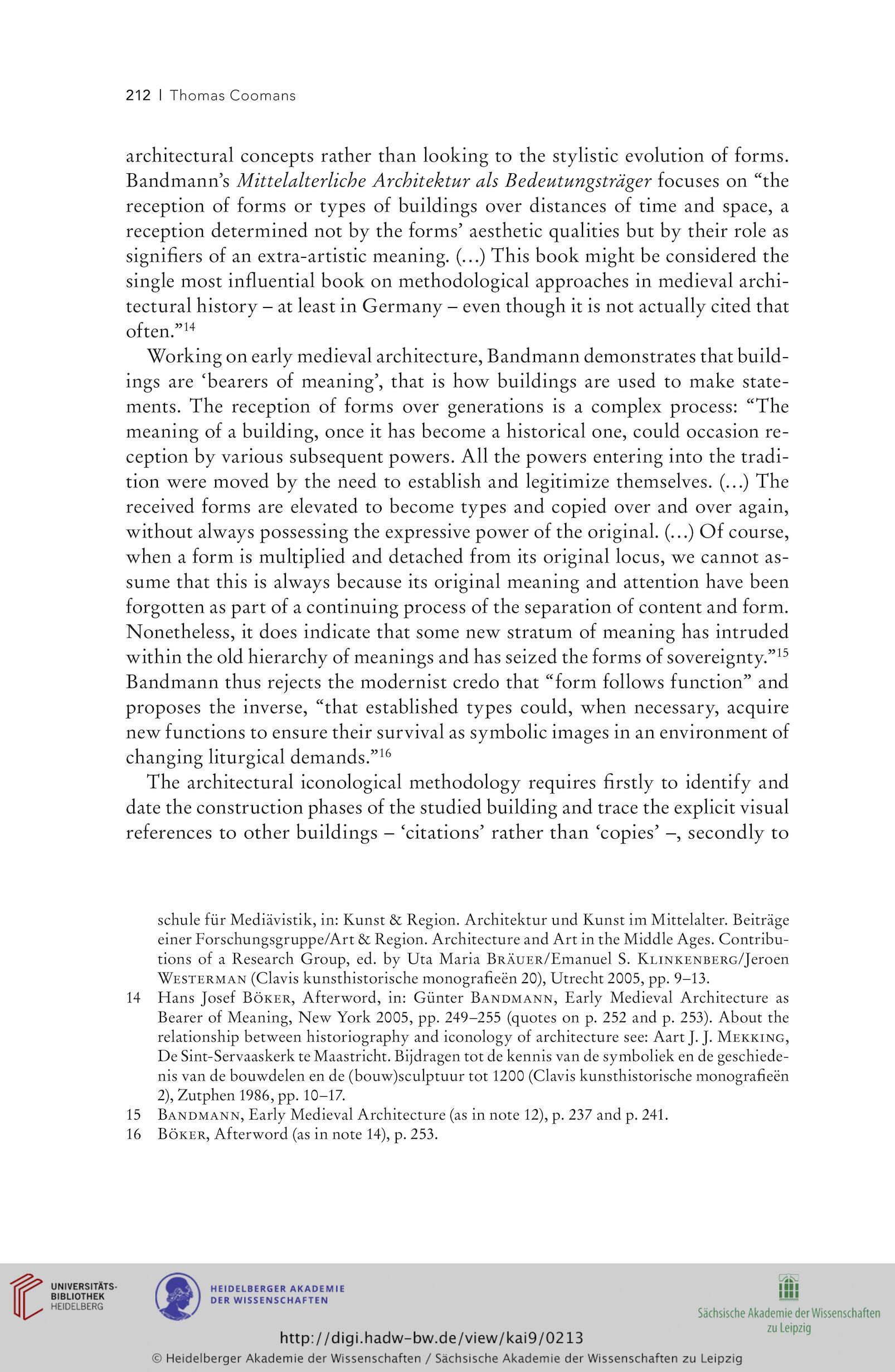212 I Thomas Coomans
architectural concepts rather than looking to the stylistic evolution of forms.
Bandmann's Mittelalterliche Architektur als Bedeutungsträger focuses on "the
reception of forms or types of buildings over distances of time and space, a
reception determined not by the forms' aesthetic qualities but by their role as
signifiers of an extra-artistic meaning. (...) This book might be considered the
single most influential book on methodological approaches in medieval archi-
tectural history - at least in Germany - even though it is not actually cited that
often."14
Working on early medieval architecture, Bandmann demonstrates that build-
ings are 'bearers of meaning', that is how buildings are used to make state-
ments. The reception of forms over generations is a complex process: "The
meaning of a building, once it has become a historical one, could occasion re-
ception by various subsequent powers. All the powers entering into the tradi-
tion were moved by the need to establish and legitimize themselves. (...) The
received forms are elevated to become types and copied over and over again,
without always possessing the expressive power of the original. (...) Of course,
when a form is multiplied and detached from its original locus, we cannot as-
sume that this is always because its original meaning and attention have been
forgotten as part of a continuing process of the separation of content and form.
Nonetheless, it does indicate that some new stratum of meaning has intruded
within the old hierarchy of meanings and has seized the forms of sovereignty."15
Bandmann thus rejects the modernist credo that "form follows function" and
proposes the inverse, "that established types could, when necessary, acquire
new functions to ensure their survival as symbolic images in an environment of
changing liturgical demands."16
The architectural iconological methodology requires firstly to identify and
date the construction phases of the studied building and trace the explicit visual
references to other buildings - 'citations' rather than 'copies' -, secondly to
schule für Mediävistik, in: Kunst & Region. Architektur und Kunst im Mittelalter. Beiträge
einer Forschungsgruppe/Art & Region. Architecture and Art in the Middle Ages. Contribu-
tions of a Research Group, ed. by Uta Maria BRÄUER/Emanuel S. KLINKENBERG/Jeroen
Westerman (Clavis kunsthistorische monografieen 20), Utrecht 2005, pp. 9-13.
14 Hans Josef Böker, Afterword, in: Günter Bandmann, Early Medieval Architecture as
Bearer of Meaning, New York 2005, pp. 249-255 (quotes on p. 252 and p. 253). About the
relationship between historiography and iconology of architecture see: Aart J. J. Mekking,
De Sint-Servaaskerk te Maastricht. Bijdragen tot de kennis van de symboliek en de geschiede-
nis van de bouwdelen en de (bouw)sculptuur tot 1200 (Clavis kunsthistorische monografieen
2), Zutphen 1986, pp. 10-17.
15 Bandmann, Early Medieval Architecture (as in note 12), p. 237 and p. 241.
16 Böker, Afterword (as in note 14), p. 253.
architectural concepts rather than looking to the stylistic evolution of forms.
Bandmann's Mittelalterliche Architektur als Bedeutungsträger focuses on "the
reception of forms or types of buildings over distances of time and space, a
reception determined not by the forms' aesthetic qualities but by their role as
signifiers of an extra-artistic meaning. (...) This book might be considered the
single most influential book on methodological approaches in medieval archi-
tectural history - at least in Germany - even though it is not actually cited that
often."14
Working on early medieval architecture, Bandmann demonstrates that build-
ings are 'bearers of meaning', that is how buildings are used to make state-
ments. The reception of forms over generations is a complex process: "The
meaning of a building, once it has become a historical one, could occasion re-
ception by various subsequent powers. All the powers entering into the tradi-
tion were moved by the need to establish and legitimize themselves. (...) The
received forms are elevated to become types and copied over and over again,
without always possessing the expressive power of the original. (...) Of course,
when a form is multiplied and detached from its original locus, we cannot as-
sume that this is always because its original meaning and attention have been
forgotten as part of a continuing process of the separation of content and form.
Nonetheless, it does indicate that some new stratum of meaning has intruded
within the old hierarchy of meanings and has seized the forms of sovereignty."15
Bandmann thus rejects the modernist credo that "form follows function" and
proposes the inverse, "that established types could, when necessary, acquire
new functions to ensure their survival as symbolic images in an environment of
changing liturgical demands."16
The architectural iconological methodology requires firstly to identify and
date the construction phases of the studied building and trace the explicit visual
references to other buildings - 'citations' rather than 'copies' -, secondly to
schule für Mediävistik, in: Kunst & Region. Architektur und Kunst im Mittelalter. Beiträge
einer Forschungsgruppe/Art & Region. Architecture and Art in the Middle Ages. Contribu-
tions of a Research Group, ed. by Uta Maria BRÄUER/Emanuel S. KLINKENBERG/Jeroen
Westerman (Clavis kunsthistorische monografieen 20), Utrecht 2005, pp. 9-13.
14 Hans Josef Böker, Afterword, in: Günter Bandmann, Early Medieval Architecture as
Bearer of Meaning, New York 2005, pp. 249-255 (quotes on p. 252 and p. 253). About the
relationship between historiography and iconology of architecture see: Aart J. J. Mekking,
De Sint-Servaaskerk te Maastricht. Bijdragen tot de kennis van de symboliek en de geschiede-
nis van de bouwdelen en de (bouw)sculptuur tot 1200 (Clavis kunsthistorische monografieen
2), Zutphen 1986, pp. 10-17.
15 Bandmann, Early Medieval Architecture (as in note 12), p. 237 and p. 241.
16 Böker, Afterword (as in note 14), p. 253.






